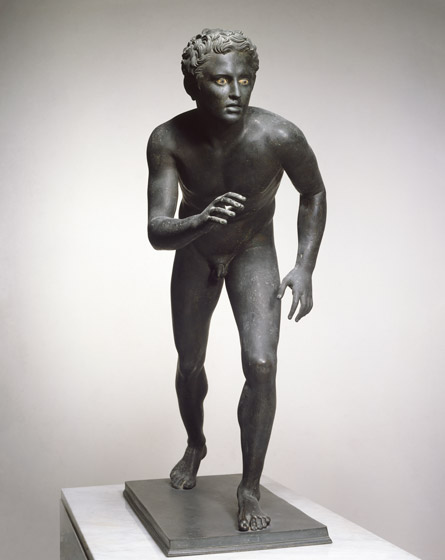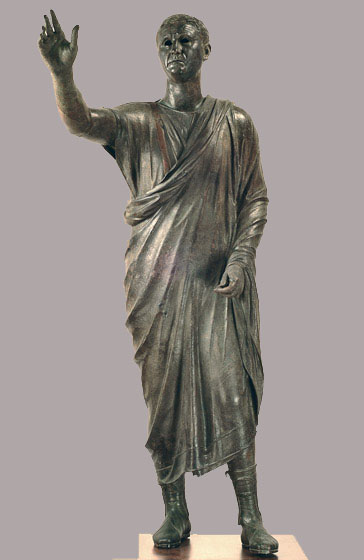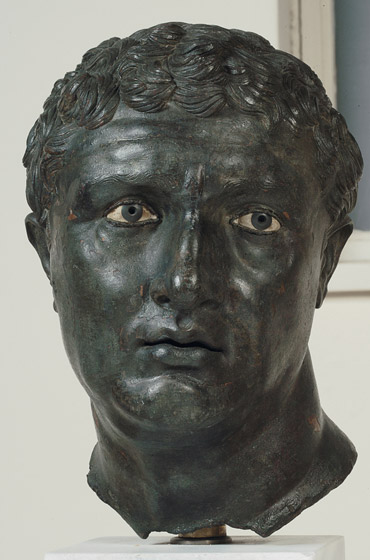First of all, yet again I must apologize for another lengthy delay between blog posts. This is particularly embarrassing in light of my recent resolution to try to do one a week. I can plead the press of the holidays and also observe that I haven’t been getting out that much lately (wretched old man!) and haven’t had much writing news to announce either. Yet rather than make excuses, I’ll write instead about something I find interesting in the hope you do as well: the exhibit of ancient Greek and Roman bronze statutary currently at the National Gallery of Art.
I was a history major in college and my field was ancient or Greco-Roman history. My interest in the Hellenistic Age goes back further than that, however. Ancient civilizations particularly interested me as a child, sparked by my parents giving me a copy of the D’Aulaires’ Book Of Greek Myths and further strengthened by reading novels in high school like I, Claudius by Robert Graves. I’m what would have been called a Hellenophile in an earlier era, an admirer of ancient Greek culture. While I’m not hyperbolic enough to call them the Fathers of Western Civilization, they were still an extremely original and clever people, adventurous and resourceful, who took the few resources their stony soil provided, grapes, olives, and the sea, and forged a extraordinary civilization from that meager basis, indeed, innovative in the extreme.
One of the most fascinating developments in Greek sculpture and technology was their perfection and skill in casting lifelike and animated sculptures from bronze. The exhibit provides captioned illustrations that explain very well how ancient Greek and Roman sculptors were able to produce bronze sculptures through the use of clay and wax casts. This was a major invention and became a lost art with the fall of Rome (bronze sculptures weren’t cast again in Italy until Renaissance times). We think of antique sculptures as eyeless and blank, but that’s only because most of the examples that remain are battered and half-ruined by age and abuse. The artists made eyelashes from cut copper with eyesockets of stone or metal set into them. Surviving examples are stunningly lifelike in their expressions:
The medium of bronze allowed the artists to show amazing detail such as a fine, thin beard or sweat-matted hair, but also permitted dynamic, energetic compositions such as the Boy Runner statue excavated near the ruins of Pompeii:

Almost two thousand years old and still the picture of energy about to be unleashed, like a coiled spring.
Note how the preserved eyes add to the statue’s power, the boy’s determination and vitality. This is just one of a number of true artistic masterpieces, many done by anonymous craftsmen whose names we’ll never know. As I observed before, I try not to idealize or idolize those who lived millennia ago. Their ignorance of basic information like internal medicine or sanitation, to give but two promiment examples, was absolutely abysmal and Hobbes’s axiom about life without society being poor, nasty, brutish and short applied even more strenuously then by multiple geometric factors than it does today. In my opinion, that very ignorance is exactly the reason why the Greeks and Romans deserve credit for the truly extraordinary achievements that they did bring about, that they were able to do so much with so little.
I believe that this exhibit is an outstanding example of the truth of this observation. It’s a rare event, one that has brought together one of the largest gatherings of antique statuary assembled from museums world-wide. After being seen at the Getty Museum in Los Angeles, the exhibit at the National Gallery is the only other American venue. It ends March 20, 2016. To anyone who has the opportunity and the means to go, I recommend the exhibit highly:
http://www.nga.gov/content/ngaweb/exhibitions/2015/power-and-pathos.html





